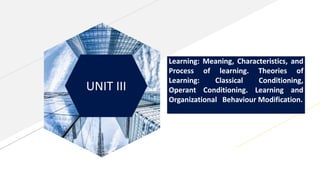
LEARNING
- 1. UNIT III Subtitle Learning: Meaning, Characteristics, and Process of learning. Theories of Learning: Classical Conditioning, Operant Conditioning. Learning and Organizational Behaviour Modification.
- 2. Learning can be defined as the permanent change in behavior due to direct and indirect experience. It means change in behavior, attitude due to education and training, practice and experience. It is completed by acquisition of knowledge and skills, which are relatively permanent. • Learning involves change; it may or may not guarantee improvement. It should be permanent in nature, that is learning is for lifelong. • The change in behavior is the result of experience, practice and training. Learning is reflected through behavior. Add a footer 2
- 3. FR Factors Affecting Learning How Learning Occurs? • Classical Conditioning Theory • Occurs when a conditioned stimulus is coupled with an unconditioned stimulus. Usually, the conditioned stimulus (CS) is an impartial stimulus like the sound of a tuning fork, the unconditioned stimulus (US) is biologically effective like the taste of food and the unconditioned response (UR) to the unconditioned stimulus is an unlearned reflex response like salivation or sweating. Classical Conditioning Theory Operant Conditioning Theory Social Learning Theory Cognitive Learning Theory 3 MOTIVATION, PRACTICE, ENVIRONMENT, AND MENTAL GROUP
- 4. FR This principle is a learning process in which a behaviour is sensitive to or controlled by its consequences. A particular behavior usually has a reward or punishment. One’s behavior will depend on a specific way from which they will benefit or try to avoid behavior where they will get nothing. Skinner argued that creating pleasant consequences for specific forms of behavior would increase the frequency of that particular behavior. OPERANT CONDITIONING THEORY Add a footer 4
- 5. FR Social Learning Theory 5 Social Learning theory is also called observational learning theory. This theory emphasizes on learning through observation of other’s. The main assumptions of social learning theory are as follows: – Learning is not actually behavioural, rather it is a cognitive process that takes place in a social context. Learning can occur by observing a behaviour and observing the consequences of the behaviour (known as vicarious reinforcement). Learning involves observation, extracting information from those observations, and making decisions about behaviour performance (known as observational learning or modelling). Thus, learning may go beyond an observable change in behaviour. Reinforcement plays an important role in learning but is not solely responsible for learning. The learner is not a passive recipient of information. Understanding, environment and behaviour all mutually influence each other.
- 6. FR Add a footer 6 Cognitive Learning Theory: – Cognition defines a person’s thoughts, ideas, knowledge, interpretation, understanding about himself and about the environment. Learning involves gaining knowledge and understanding it by absorbing information in the form of principles, concepts and facts and then internalizing it. It assumes that a person learns the meaning of various objects and events and also learns to respond based on the meaning given to stimuli. The knowledge and understanding of learners can be enriched and internalized by exposing them to learning materials e.g. Case studies , projects, problem solving activities can also be used for this purpose. Eg. Self – directed learning,
- 7. Organizational Behaviour Modification An individual’s behavior in an organization is directly or indirectly affected by learning. Example − Employee skills, manager’s attitude are all learned. Behavior can be improved by following the listed tips − • Reducing absenteeism by rewarding employees for their fair attendance. • Improving employee discipline by dealing with employee’s undesirable behavior, drinking at workplace, stealing, coming late, etc. by taking appropriate actions like oral reprimands, written warnings and suspension. • Developing training programs more often so as to grab the trainees’ attention, provide required motivational properties etc.
- 8. FR Emotions: Meaning, Emotions at Workplace Emotions are mental states brought on by neurophysiological changes, variously associated with thoughts, feelings, behavioural responses, and a degree of pleasure or displeasure. Emotion is defined as a short, intense feeling resulting from some event. Not everyone reacts to the same situation in the same way. For example, a manager's way of speaking can cause one person to feel motivated, another to feel angry, and a third to feel sad. Emotions Meaning: Emotions are well-defined feelings, bodily sensations, behaviour, or qualities of consciousness, such as joy, happiness, anger, or sadness that reflect the personal significance of emotion-arousing events. The major types of emotions include sadness, compassion, fear, anger, surprise, excitement, shame, anxiety, pleasure, guilt, interest, hatred, and happiness. Emotions have a deep effect on almost everything a person does in the workplace. Many discoveries have revealed that our perceptions, attitudes, decisions, and behaviour are affected by both cognition and emotion and that the latter often has the greater influence. People show their emotions when they are happy about something, angry at someone, or afraid 8
- 10. Thank You.